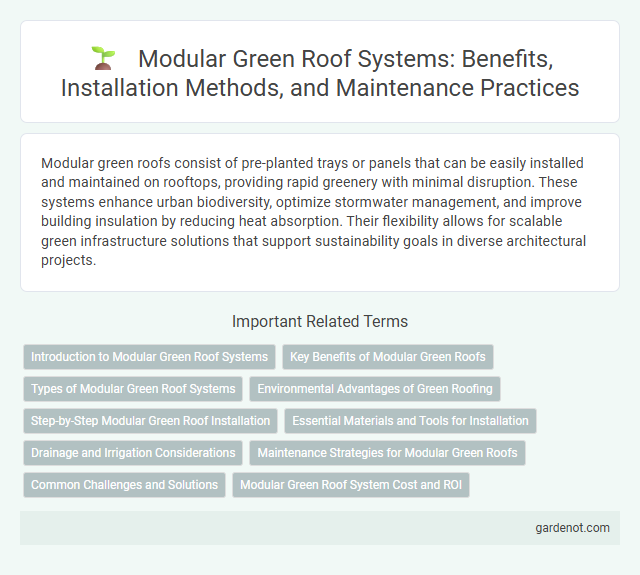Modular green roofs consist of pre-planted trays or panels that can be easily installed and maintained on rooftops, providing rapid greenery with minimal disruption. These systems enhance urban biodiversity, optimize stormwater management, and improve building insulation by reducing heat absorption. Their flexibility allows for scalable green infrastructure solutions that support sustainability goals in diverse architectural projects.
Introduction to Modular Green Roof Systems
Modular green roof systems consist of pre-planted vegetation units housed in trays or panels, designed for easy installation and maintenance on various roof types. These systems improve urban biodiversity, enhance insulation, and reduce stormwater runoff by incorporating drought-tolerant plants and lightweight growing media. Their flexible design allows for quick replacement and adaptability, making them ideal for residential, commercial, and institutional buildings seeking sustainable roofing solutions.
Key Benefits of Modular Green Roofs
Modular green roofs offer rapid installation and easy maintenance due to their pre-grown vegetation mats housed in removable trays, reducing labor costs and minimizing disruption. These systems enhance thermal insulation, decreasing building energy consumption while improving stormwater management by retaining significant rainfall volumes. Furthermore, modular green roofs contribute to urban biodiversity, support air quality improvement, and extend roof lifespan by protecting the membrane from UV radiation and temperature fluctuations.
Types of Modular Green Roof Systems
Modular green roof systems include tray-based, panel-based, and mat-based types, each designed for specific installation and maintenance needs. Tray-based systems offer flexibility and ease of replacement, while panel-based systems provide structural stability and uniform planting surfaces. Mat-based systems use pre-grown vegetation mats for rapid establishment and consistent coverage on rooftops.
Environmental Advantages of Green Roofing
Modular green roofs significantly reduce urban heat island effects by providing natural insulation and cooling through vegetation coverage. They enhance stormwater management by absorbing and filtering rainfall, thereby decreasing runoff and reducing the burden on municipal drainage systems. Furthermore, these systems improve air quality by trapping airborne pollutants and promoting biodiversity in urban environments.
Step-by-Step Modular Green Roof Installation
Modular green roof installation begins with a thorough assessment of the structural load capacity followed by the preparation of the roof deck to ensure proper drainage and waterproofing. Next, lightweight modular trays pre-planted with drought-resistant vegetation are securely placed and interconnected to cover the roof surface uniformly. The final step involves regular maintenance including irrigation, weed control, and inspection to promote healthy plant growth and extend the system's lifespan.
Essential Materials and Tools for Installation
Modular green roof installation requires essential materials such as pre-planted growth mats, waterproof membranes, root barriers, drainage boards, and lightweight growing media formulated for optimal water retention and aeration. Key tools include utility knives for cutting mats, trowels for spreading soil, staple guns or adhesive for securing modules, and moisture meters to monitor substrate moisture levels. Proper selection and use of these materials and tools ensure efficient installation and long-term green roof performance.
Drainage and Irrigation Considerations
Modular green roofs incorporate integrated drainage layers to efficiently manage water runoff while preventing root saturation, promoting healthy vegetation growth. These systems often include built-in irrigation channels or reservoirs that optimize water distribution and retention, reducing dependence on external watering. Effective drainage and irrigation design enhances the longevity of the roofing membrane and supports sustainable urban green infrastructure.
Maintenance Strategies for Modular Green Roofs
Modular green roofs require regular inspections to ensure the health of vegetation and to prevent drainage blockages, focusing on efficient water management and soil nutrient replenishment. Scheduled maintenance includes checking irrigation systems, removing weeds, and replacing damaged modules to sustain optimal plant growth and structural integrity. Employing smart monitoring technologies can contribute to proactive maintenance, reducing long-term costs and extending the green roof's lifespan.
Common Challenges and Solutions
Modular green roofs often face challenges such as limited root space, weight constraints, and drainage issues that can impact plant health and structural integrity. Solutions include using lightweight, engineered soil substrates to reduce load, integrating efficient drainage layers to prevent waterlogging, and selecting drought-tolerant plant species adapted to confined environments. Regular maintenance protocols and modular design flexibility further enhance sustainability and resilience of green roof systems.
Modular Green Roof System Cost and ROI
Modular green roof systems typically cost between $20 to $40 per square foot, depending on materials and installation complexity. These systems offer a faster installation process and easier maintenance compared to traditional green roofs, leading to lower labor costs and quicker operational benefits. The return on investment (ROI) is driven by energy savings, extended roof longevity, and stormwater management, often recouping initial costs within 7 to 12 years.
Modular green roof Infographic

 gardenot.com
gardenot.com